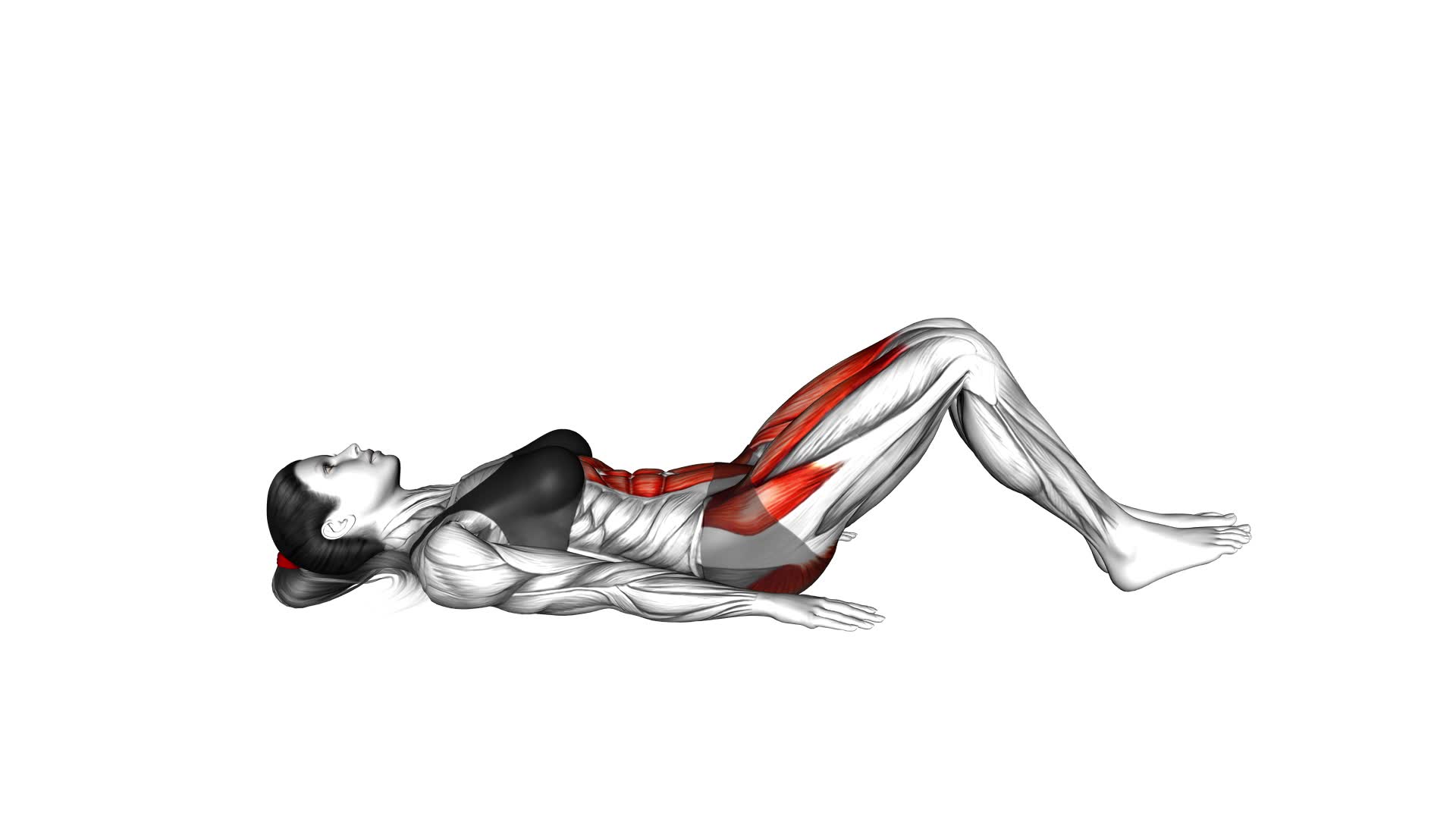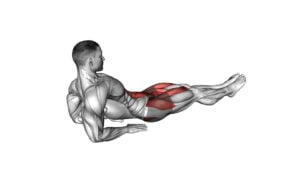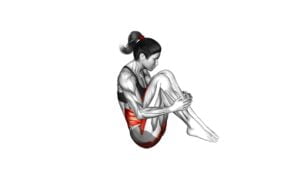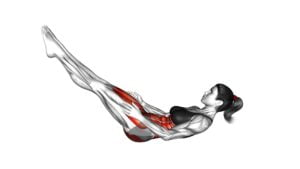Lying Bent Leg Tuck (female) – Video Exercise Guide & Tips

Get ready to strengthen your core and sculpt your abs with the lying bent leg tuck exercise! In this video exercise guide, we'll show you how to properly perform this move to maximize results.
Watch This Exercise Video
Whether you're a beginner or looking to increase the difficulty, we've got modifications and variations for you. Say goodbye to boring crunches and hello to a challenging and effective workout.
Let's dive in and get those abs burning!
Key Takeaways
- Lying bent leg tuck targets core muscles, including abs, obliques, and lower back.
- Proper form and technique involve keeping the lower back pressed against the ground and using abdominal muscles to initiate the movement.
- Beginners should focus on keeping the head and shoulders relaxed, avoiding using momentum, and starting with progression exercises.
- To increase difficulty, variations such as extending the range of motion, adding resistance, or performing the exercise with one leg lifted off the ground can be implemented.
Benefits of Lying Bent Leg Tuck
To maximize your workout results, performing the lying bent leg tuck can provide numerous benefits for your overall strength and stability. This exercise specifically targets your core muscles, helping to strengthen your abs, obliques, and lower back. By engaging these muscles, you can improve your core strength, which is essential for maintaining proper posture and preventing injuries.
In addition to core strength, the lying bent leg tuck also helps to improve flexibility. As you bring your knees towards your chest, you're stretching your hip flexors and hamstrings. Over time, this can lead to increased flexibility in these areas, allowing for better range of motion in other exercises and daily activities.
By incorporating the lying bent leg tuck into your workout routine, you can reap the benefits of improved core strength and flexibility. However, it's important to ensure that you're using proper form and technique to maximize the effectiveness of the exercise and prevent injuries.
Proper Form and Technique
To perform the lying bent leg tuck exercise with proper form and technique, you should start by lying flat on your back with your knees bent and feet flat on the ground. Here are some important tips to ensure you're executing the exercise correctly:
- Keep your lower back pressed firmly against the ground throughout the movement to engage your core muscles effectively.
- As you lift your legs, focus on using your abdominal muscles to initiate the movement. Avoid using momentum or swinging your legs.
- Slowly bring your knees towards your chest while keeping your feet together. Aim to bring your knees as close to your chest as possible without straining your lower back.
It is important to be aware of some common mistakes and misconceptions associated with this exercise. Some individuals may tend to lift their heads or shoulders off the ground, which can strain the neck and reduce the effectiveness of the exercise. Remember to keep your upper body relaxed and avoid any unnecessary tension.
Now that you have a good understanding of the proper form and technique for the lying bent leg tuck exercise, let's move on to discussing modifications for beginners.
Modifications for Beginners
If you're new to the lying bent leg tuck exercise, there are a few modifications you can make to make it more accessible.
The lying bent leg tuck is a challenging exercise that targets the abdominal muscles and hip flexors. However, for beginners, it can be difficult to perform the exercise with proper form and technique.
One common mistake to avoid is lifting your head and shoulders off the ground too much. This can put strain on your neck and upper back. Instead, focus on keeping your head and shoulders relaxed and only lifting them slightly off the ground.
Another mistake to avoid is using momentum to swing your legs up. This takes away from the effectiveness of the exercise and can lead to injury. Instead, focus on using your core muscles to lift your legs in a controlled manner.
For beginners, it's important to start with progression exercises to build strength and stability.
One progression exercise is the lying bent knee raise. Lie on your back with your knees bent and feet flat on the ground. Slowly lift one knee towards your chest, keeping your core engaged. Lower the leg back down and repeat on the other side.
Another progression exercise is the lying straight leg raise. Lie on your back with your legs straight and together. Slowly lift both legs towards the ceiling, keeping your core engaged. Lower the legs back down and repeat.
Variations to Increase Difficulty
To increase the difficulty of the lying bent leg tuck exercise, try incorporating a greater range of motion and adding resistance. Here are three advanced progressions and modifications you can try:
- Extended Range of Motion: Instead of stopping when your knees are bent at a 90-degree angle, extend your legs further towards your chest. This will require more strength and control to bring your legs back to the starting position.
- Weighted Leg Tucks: Hold a dumbbell or medicine ball between your feet while performing the exercise. The additional weight will increase the resistance and challenge your core muscles even more.
- Single Leg Bent Leg Tucks: Lift one leg off the ground and perform the exercise with the other leg. This variation will place more emphasis on the working leg and challenge your balance and stability.
Remember to always maintain proper form and control throughout these advanced modifications. Start with a weight or range of motion that challenges you but still allows you to perform the exercise with proper technique. As you become stronger and more comfortable, gradually increase the difficulty to continue challenging your muscles.
Tips for Maximizing Results
To optimize your results, focus on consistency and intensity throughout your lying bent leg tuck workouts. Consistency is key when it comes to seeing progress. Make sure to schedule regular workout sessions and stick to them. Aim for at least three to four workouts per week to maintain momentum and build strength.
In addition to consistency, intensity is crucial for maximizing your results. Push yourself during each repetition of the lying bent leg tuck exercise. Focus on contracting your abdominal muscles and lifting your legs as high as possible. As you become more comfortable with the movement, try adding resistance by holding a dumbbell between your feet or using ankle weights.
While exercise is important for achieving your goals, it's equally important to pay attention to your diet. Incorporate a balanced diet that includes lean proteins, healthy fats, and complex carbohydrates. Avoid processed foods and sugary drinks, as they can hinder progress and increase body fat.
Recovery strategies are also essential for maximizing your results. Make sure to get enough sleep to allow your body to repair and regenerate. Incorporate rest days into your workout routine to prevent overtraining and reduce the risk of injury. Additionally, consider incorporating stretching exercises or yoga to improve flexibility and aid in recovery.
Frequently Asked Questions
How Many Calories Does the Lying Bent Leg Tuck Exercise Burn?
The lying bent leg tuck exercise is a great way to target your core muscles. It involves lying on your back with your knees bent and pulling them toward your chest, engaging your abs.
While this exercise can help strengthen your core, it may not burn a significant number of calories on its own. However, incorporating variations of the lying bent leg tuck, such as adding weights or performing it on a stability ball, can increase the intensity and potentially burn more calories.
How Long Should I Hold the Lying Bent Leg Tuck Position?
To effectively perform the lying bent leg tuck exercise, you should aim to hold the position for about 30 seconds to 1 minute. This will help you engage your core muscles and build strength.
However, it's important to listen to your body and start with a shorter duration if you're a beginner.
As for variations, there isn't a modified version specifically for beginners, but you can use a medicine ball or resistance band to add more challenge and intensity to the exercise.
Can the Lying Bent Leg Tuck Exercise Help in Reducing Belly Fat?
The lying bent leg tuck exercise can be effective for toning your abdominal muscles. By engaging your core and bringing your knees towards your chest, it targets the lower abs and helps to strengthen and define them.
However, it's important to note that spot reduction isn't possible, so incorporating the lying bent leg tuck into a comprehensive workout routine is key for overall weight loss. Combine it with cardio and a healthy diet for best results.
Is It Safe to Perform the Lying Bent Leg Tuck Exercise During Pregnancy?
During pregnancy, it's important to prioritize your safety and the well-being of your baby. Before performing any exercise, it's advisable to consult with your healthcare provider. They can provide specific modifications that are safe for you and your baby.
The lying bent leg tuck exercise can be beneficial for strengthening the core muscles. However, during pregnancy, it may need to be modified or avoided altogether to avoid any potential risks.
Can the Lying Bent Leg Tuck Exercise Help in Improving Posture?
Improving your posture is important for maintaining a healthy and strong body.
The lying bent leg tuck exercise can be beneficial in this regard. By incorporating this exercise into your routine, you can work on strengthening your core muscles and improving flexibility.
This exercise targets the abdominal muscles, hip flexors, and lower back, which are all important for maintaining good posture.
Remember to consult with a fitness professional before starting any new exercise program.
Conclusion
In conclusion, the lying bent leg tuck exercise is a great way to strengthen and tone your core muscles. By following proper form and technique, beginners can gradually build their strength and progress towards more advanced variations.
Adding modifications or increasing the difficulty level can help to challenge your muscles and maximize results.
Incorporating this exercise into your fitness routine can lead to improved core strength and overall body stability.

Author
Years ago, the spark of my life’s passion ignited in my mind the moment I stepped into the local gym for the first time. The inaugural bead of perspiration, the initial endeavor, the very first surge of endorphins, and a sense of pride that washed over me post-workout marked the beginning of my deep-seated interest in strength sports, fitness, and sports nutrition. This very curiosity blossomed rapidly into a profound fascination, propelling me to earn a Master’s degree in Physical Education from the Academy of Physical Education in Krakow, followed by a Sports Manager diploma from the Jagiellonian University. My journey of growth led me to gain more specialized qualifications, such as being a certified personal trainer with a focus on sports dietetics, a lifeguard, and an instructor for wellness and corrective gymnastics. Theoretical knowledge paired seamlessly with practical experience, reinforcing my belief that the transformation of individuals under my guidance was also a reflection of my personal growth. This belief holds true even today. Each day, I strive to push the boundaries and explore new realms. These realms gently elevate me to greater heights. The unique combination of passion for my field and the continuous quest for growth fuels my drive to break new ground.







